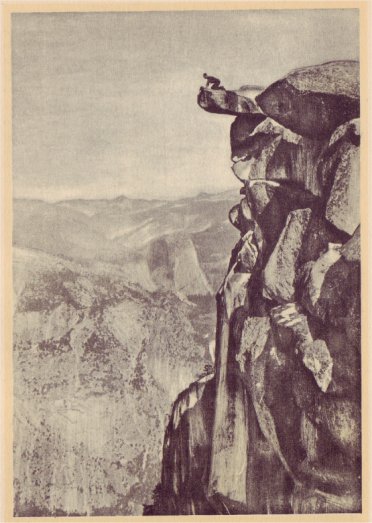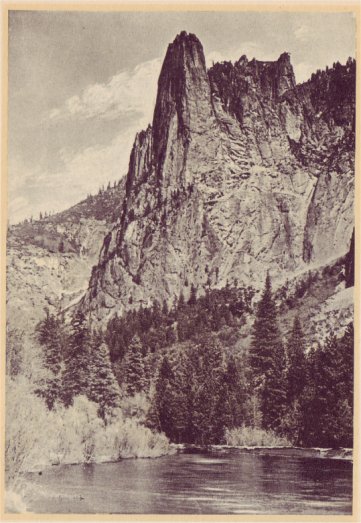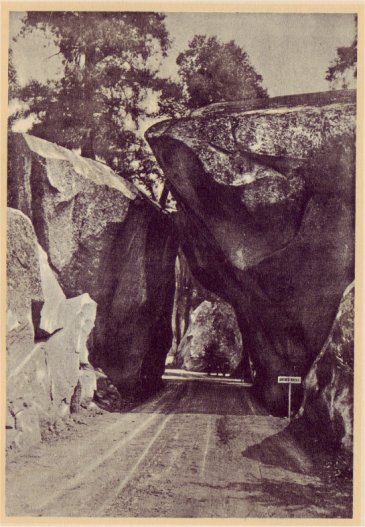
Overhanging Rock, at Glacier Point, from which it is a sheer drop of 3,200 feet to Camp Curry in Yosemite Valley
| Online Library: | Title | Author | California | Geology | History | Indians | Muir | Mountaineering | Nature | Management |
Yosemite > Library > Lights & Shadows > Pioneer Days—Early Travelers >
Next: Old Landmarks • Contents • Previous: Discovery of Yosemite
Sight-Seeing in Yosemite began in 1855, six years after the discovery of gold in California. H. M. Hutchings, Thomas Ayers, Walter Millard, and Alexander Stair organized the first tourist party to go into this wilderness of the Indians and the grizzly bears. It was a three days’ trip on horseback, each way, over an indistinct and all but impassable trail. Thanks to the aid of two Indian guides they reached the Valley safely, and for five days, as Hutchings puts it, they luxuriated in a “scenic banquet.” Picture them, a poet, an artist, and two ardent nature lovers, steeping themselves in all this magnificence, unknown almost to the world! The enthusiastic reports of this trip did much to stimulate interest in the Valley; Hutchings broadcasting with his articles and Ayers with the first pictures of Yosemite Falls, which were, later, to become even more widely photographed than the Prince of Wales. As a result of this early publicity, two other intrepid parties ventured in before the year was out.
These were the drum majors leading that long, long procession of tourists which has been trekking to Yosemite ever since. The following year the first women entered the Valley, with true pioneer spirit, and by so doing allayed the fear as to Indians and grizzlies, and thereby stimulated travel considerably!
The Valley was not crowded in those earliest years. Records show that about twenty or thirty visitors was the annual average for that first ten years. Only the hardiest undertook the trip. But in 1864 Congress turned Yosemite over to California for a State Park, and the tourist record jumped to 147. From that time on travel increased by fifty or a hundred each year, until, in 1875, three thousand visitors registered in the Park. According to Dr. Bunnell, nine tenths of them came either from Europe or the Atlantic Coast. Californians were too busy in those days creating their own miracles to view nature’s.
Long before there were wagon roads, foot and horse trails had to be blazed, and this involved considerable expense and labor, as well

PHOTO BY DE COU
[click to enlarge]
Overhanging Rock, at Glacier Point, from which it is a sheer drop of 3,200 feet to Camp Curry in Yosemite Valley |
In 1858, a year after the completion of the Wawona trail, the Coulterville trail on the north side of the Valley was finished, so that visitors might now enter by one road and leave by the other. Visitors, then, did not return to the Valley season after season, as they now do. One trip sufficed for a lifetime, and it was well to see as much of the country as possible at that time.
It was 1874, nineteen years after the first tourist party made its visit, before a wagon road into the Valley was completed. This ushered in the era of the stagecoach, and a journey to Yosemite became almost de luxe then! This first wagon road, the old Coulterville Road, was put through primarily to accommodate goldseekers, who were looking in the High Sierras for the Mother lode, the source of all the gold nuggets and dust that streams had washed down into the placer mining country. The following year, the Wawona Road was extended into Yosemite Valley from the south side, and this road, now much improved, is the present Wawona automobile road. The Big Oak Flat Road, traversing the Bret Harte country, and the first free wagon road from the edge of the Park to the floor of the Valley, was completed in 1874, shortly after the Coulterville Road was opened.
The days of the stagecoach! What pictures and emotions the phrase conjures up! Stagecoaches, gold-diggers, bandits, conviviality, and always and ever the jolting and swaying, the heat and the dust, or the thrilling fording of rivers at high water when the horses had all but to swim! Yet those were the days for which the Old-Timers still sigh!
Until the Horseshoe Route stage line was established, the trip from Stockton took two, and sometimes three, days. With the

PHOTO BY A. WIEDERSEDER
[click to enlarge]
Sentinel Rock, guardian over Yosemite Valley, resembles a Cathedral built upon a mountain |
Tales are told of the rollicking speed at which these stagecoaches sometimes traveled over the then perilous roads. The Black Devil’s Turn was a particularly perilous bend, so named for the negro driver who generally managed to take it on two wheels, giving his passengers an unbilled extra thrill. Holdups were all too common occurrences along this road in those days, when both tourists and miners might be traveling with wealth on their persons. Even forest fires failed to stop the Cannonball Express, according to one story, which relates how the driver whipped his steeds, as he came to a burning forest at a point where turning around on the narrow road was impossible, and emerged to find the back of his stagecoach smoldering. No, travel today is not what it used to be!
The wonder and delight caused by the construction of these roads into Yosemite was quite transcended, in 1907, by the completion of the Yosemite Valley Railway to its terminal at El Portal, from which point horse-drawn stages took passengers into the Valley proper. Automobiles were admitted to the National Parks in 1915. That act has done more than anything else to increase travel to Yosemite. The beautiful and spectacular Tioga Road, begun in the days of the gold rush and never completed, was rehabilitated in 1915, largely through the efforts and generosity of Stephen T. Mather, Director of the National Park Service. He and some friends bought the private mining road to which the Government could not get claim, and presented it to the people of the United States, and in so doing opened to automobile travel all the grandeur of the higher Yosemite country.

PHOTO BY BEST STUDIO
[click to enlarge]
Arched Rocks, near the entrance of Yosemite Valley on the El Portal Road |
Next: Old Landmarks • Contents • Previous: Discovery of Yosemite
| Online Library: | Title | Author | California | Geology | History | Indians | Muir | Mountaineering | Nature | Management |
http://www.yosemite.ca.us/library/lights_and_shadows/early_travelers.html